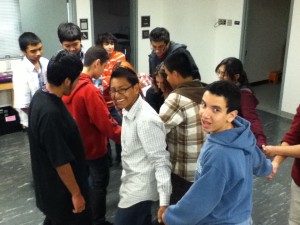On Monday, September 17, 2012, I proudly delivered a guest lecture to COMM 203: Mass Media & Communication at USC’s Annenberg School for Communication and Journalism. This opportunity to share ideas with 220 undergraduates was made possible by my mentor and cherished friend, Dr. Stacy Smith, the course’s long-time and much lauded instructor.
Today the students completed their first mid-term; I hope that some of the material we explored together helped them to emerge triumphant. Thank you, Stacy. Thank you, Marc. Thank you, Jim. Thank you, Alex. Thank you, Mike. And last but not least, thank you, students of COMM 203!
Enriching Our Minds or Melting Our Brains? Mass Media & Measuring Exposure from Laurel Felt on Vimeo.
CORRECTIONS:
1. Computer-mediated communication: I incorrectly identified talking on an iPhone as computer-mediated communication (CMC). If partners had been emailing, instant messaging, or SMS texting on their iPhones, then this would have qualified as CMC. I’m not sure whether using video conferencing applications (e.g., video Skype, FaceTime) qualifies as CMC… It’s an interesting question since one is limited to the camera’s frame and interlocutors are geographically separate, but messages are sent/received nearly synchronously and aural and visual cues — notably, vocal tone and facial expressions — are available.
But traditionally, talking on the telephone has not been considered CMC. Perhaps this is because, although visual cues are absent, communication is spoken (not typed), synchronous (not asynchronous), and delivered via analog device (not a computer (except, of course, when it is, as in the case of a smartphone)).
2. Arousal setpoint: I misspoke when I asserted that people prefer a certain arousal setpoint; they don’t. This setpoint is basically fixed and related to temperament; in other words, it’s part of our hard-wiring. Thus, they prefer a certain amount of arousal that helps them to return to their arousal setpoint. For example, if your arousal setpoint is high, then you would seek out excitatory stimuli (e.g., Transformers 3) in order to get to that comfortable place of very aroused (which does not mean sexually “turned on,” it means stimulated/engaged, and probably has a positive relationship with adrenaline). Accordingly, if your arousal setpoint is low, then you would seek out relaxing stimuli (e.g., Bob Ross painting landscapes) to get to that comfortable place of barely aroused.
Those are the errors I noticed. If anything else seemed wrong to you, please let me know!


